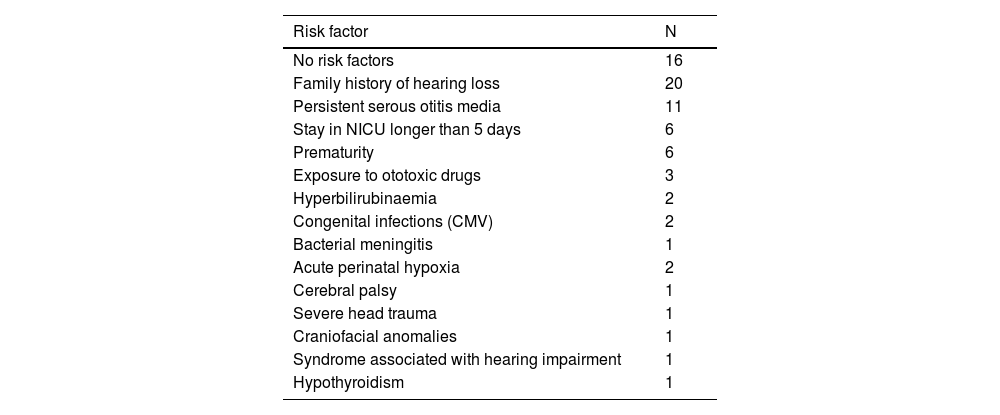To determine the percentage of children with permanent bilateral postnatal hearing loss in order to study its incidence, related risk factors, diagnosis and treatment.
MethodsRetrospective study to collect data on children diagnosed with hearing loss outside the neonatal period in the Hearing Loss Unit of the Hospital Universitario Central de Asturias, from April 2014 to April 2021.
Results52 cases met the inclusion criteria. The detection rate of congenital hearing loss in the neonatal screening programme in the same study period was 1.5 children per thousand newborns per year, adding postnatal hearing loss results in a rate of infant bilateral hearing loss of 2.7 children per thousand (55.5% and 44.4% respectively). Thirty-five children presented risk factors for hearing loss, of which 23 were at retrocochlear risk. The mean age at referral was 91.9 (18–185) months. Hearing aid fitting was indicated in 44 cases (84.6%). Cochlear implantation was indicated in eight cases (15.4%).
DiscussionAlthough congenital hearing loss accounts for the majority of childhood deafness, postnatal hearing loss has a significant incidence. This may be mainly due to: (1) that hearing impairment may arise in the first years of life, (2) that mild hearing loss as well as hearing loss in severe frequencies are undetectable by neonatal screening in some cases, (3) that some children may have false negative results.
Conclusionpostnatal hearing loss requires identification of risk factors and long-term follow-up of children with hearing loss, as it needs to be detected and treated early.
Determinar el porcentaje de niños que presentan una hipoacusia bilateral permanente postnatal para estudiar su incidencia, los factores de riesgo relacionados, su diagnóstico y su tratamiento.
MétodosEstudio retrospectivo de recogida de datos de niños diagnosticados de hipoacusia fuera del periodo neonatal en la Unidad de Hipoacusia del Hospital Universitario Central de Asturias, desde abril de 2014 hasta abril de 2021.
Resultados52 casos cumplieron los criterios de inclusión. La tasa de detección de hipoacusias congénitas del programa de cribado neonatal en el mismo periodo de estudio fue de 1,5 niños por cada mil recién nacidos al año, sumando las hipoacusias postnatales da como resultado una tasa de hipoacusia bilateral infantil de 2,7 niños por mil (55,5% y 44,4% respectivamente). Presentan factores de riesgo de hipoacusia 35, siendo 23 de riesgo retrococlear. La edad media de la derivación fue de 91,9 meses (18–185). La adaptación audioprotésica se indicó en 44 casos (84,6%). En ocho casos (15,4%) se indicó la implantación coclear.
DiscusiónAunque la hipoacusia congénita representa la mayoría de las sorderas en la infancia, la hipoacusia postnatal tiene una incidencia importante. Ésta puede responder principalmente a: (1) que el deterioro auditivo puede surgir en los primeros años de vida, (2) que la hipoacusia leve, así como las pérdidas auditivas en frecuencias graves son indetectables por el cribado neonatal en algunos casos, (3) que algunos niños pueden presentar falsos negativos en los resultados.
Conclusiónla hipoacusia postnatal requiere la identificación de factores de riesgo y el seguimiento a largo plazo de los niños que la sufre, ya que es preciso que sea detectada y tratada precozmente.










